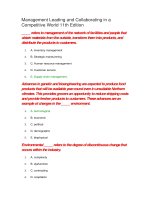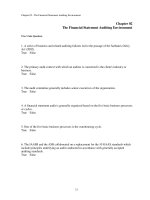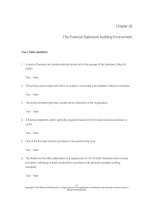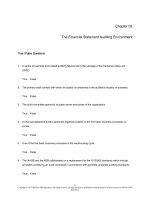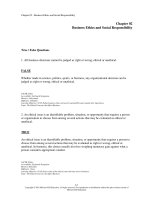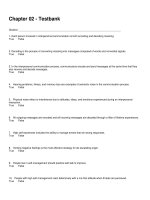Management leading and collaborating in a competitive world 12th edition bateman test bank
Bạn đang xem bản rút gọn của tài liệu. Xem và tải ngay bản đầy đủ của tài liệu tại đây (576.5 KB, 124 trang )
Chapter 02
The External and Internal Environments
True / False Questions
1. Organizations are open systems that affect and are affected by their external environments.
True
False
2. Raw materials are an example of inputs.
True
False
3. When investors bid up stock prices, companies have less capital to fuel their strategies.
True
False
4. A more diverse workforce presents managers with challenges as well as opportunities.
True
False
5. According to Michael Porter's model, the competitive environment includes rivalry among current
competitors and the impact of new entrants, substitute and complementary products, suppliers,
and customers.
True
False
6. Organizations are at an advantage if they depend on a single powerful supplier because such
dependency ensures consistency.
True
False
2-1
Copyright © 2017 McGraw-Hill Education. All rights reserved. No reproduction or distribution without the prior written consent of
McGraw-Hill Education.
7. Environmental uncertainty refers to the lack of information needed to understand or predict the
future.
True
False
8. Enrico has used environmental scanning to gather information that will help him make his
company more competitive. This is an example of cognitive intelligence.
True
False
9. April, a manager in a call center, encourages her employees to solve customers' problems
without her approval of the particular situation. In this case, April is trying to empower her
employees.
True
False
10. A strong organization culture is one in which lower-level employees do not concern themselves
with the firm's goals, priorities, and practices because management deals with those issues.
True
False
Multiple Choice Questions
11. What term is used to describe all the relevant forces outside an organization's boundaries?
A. Environmental scanning
B. Competitive intelligence
C. External environment
D. Competitive environment
E. Organizational climate
2-2
Copyright © 2017 McGraw-Hill Education. All rights reserved. No reproduction or distribution without the prior written consent of
McGraw-Hill Education.
12. A firm's _____ includes its rivals, suppliers, customers, new entrants, substitutes, and
complementary products.
A. environmental scanning
B. competitive intelligence
C. external environment
D. competitive environment
E. organizational climate
13. Stylin' Footwear buys leather and lesser quantities of cork, elastic, metal buckles, and other
materials to manufacture shoes. Which of the following is Stylin's Footwear's output?
A. Leather
B. Cork
C. Elastic
D. Buckles
E. Shoes
14. Although a top executive team may have unique _____ strengths and ideas about its goals, it
must consider _____ factors before taking action.
A. external; internal
B. internal; external
C. traditional; unconventional
D. unconventional; traditional
E. past; future
2-3
Copyright © 2017 McGraw-Hill Education. All rights reserved. No reproduction or distribution without the prior written consent of
McGraw-Hill Education.
15. Which of the following statements about the impact of the stock market is true?
A. The stock market has little effect on the amount of capital a company has.
B. If a company exceeds its performance expectations, its stock price will often drop.
C. Publicly held companies are more insulated from the stock market than privately held
companies.
D. The stock market may have a profound effect on the behavior of individual managers.
E. Stock market fluctuations have little effect on the compensation of managers.
16. A failure to develop a strategy that incorporates _____ may doom a firm to obsolescence.
A. hierarchical bureaucracy
B. many layers of middle management
C. classic production methods
D. technological advances
E. closed communication systems
17. Which of the following is a U.S. government policy or action that is most likely to provide an
opportunity for businesses?
A. deductions in the tax code
B. fines on heavy polluters
C. laws against bribing officials
D. court rulings against monopolies
E. failure to rule a new product as safe
2-4
Copyright © 2017 McGraw-Hill Education. All rights reserved. No reproduction or distribution without the prior written consent of
McGraw-Hill Education.
18. What are demographics?
A. Trends regarding how the people within a society think and behave
B. Conditions that prevent new companies from entering an industry
C. Measures of various characteristics of the people who make up social units
D. The fixed costs that buyers face if they change suppliers
E. The lack of information needed to understand or predict the future
19. How is immigration affecting U.S. demographics?
A. It is increasing the diversity of the workforce.
B. It is decreasing the number of workers.
C. It is decreasing the number of consumers.
D. It is making the educational levels of the workforce more similar.
E. It is decreasing the amount of paperwork needed to hire workers.
20. Which of the following was introduced as the result of an evolving societal trend?
A. Shares of stock
B. Hourly wages
C. Levels of management
D. Offshoring
E. Family leave
21. Which of the following was designed to help managers analyze the competitive environment and
adapt to or even influence the nature of competition?
A. Dell's IdeaStorm
B. Michael Porter's model
C. B2B selling
D. Peter Drucker's theory
E. Organizational smoothing
2-5
Copyright © 2017 McGraw-Hill Education. All rights reserved. No reproduction or distribution without the prior written consent of
McGraw-Hill Education.
22. Which of the following is a barrier to entry?
A. Consumer demand for a product
B. Lack of brand recognition
C. The existence of a popular complement
D. A low-cost distribution method
E. An inexpensive production process
23. Klaus's office has always used Tangerine computers. His technical people have suggested that
he switch all his employees over to Vale computers. Klaus is reluctant because it will mean not
only replacing all the computers but also buying all new software and taking the time to train
everyone. Klaus is worried about
A. barriers to entry.
B. benchmarking.
C. environmental uncertainty.
D. switching costs.
E. strategic maneuvering.
24. Supply chain management refers to the
A. search for information that is unavailable to most people and the process of interpreting what is
important and what is not.
B. identification of the best-in-class performance by a company in a given area and the
comparison of your processes to the company's processes.
C. procedure of sharing power with employees, thereby enhancing their confidence and their
belief that they are influential contributors to the organization.
D. creation of new products, advanced production techniques, and better ways of managing and
communicating.
E. managing of the network of facilities and people that obtain raw materials, transform them into
products, and distribute them to customers.
2-6
Copyright © 2017 McGraw-Hill Education. All rights reserved. No reproduction or distribution without the prior written consent of
McGraw-Hill Education.
25. The goal of _____ is having the right product in the right quantity at the right place at the right
cost.
A. barriers to entry
B. benchmarking
C. supply chain management
D. empowerment
E. open systems
26. _____ means searching for and sorting through information about the environment.
A. Environmental uncertainty
B. Competitive intelligence
C. Domain selection
D. Environmental scanning
E. Strategic maneuvering
27. A human resources manager is considering changing her company's vacation policy. Before she
makes a proposal to the senior executive team, she researches the vacation policies of other
leading companies in her industry. This is an example of _____.
A. benchmarking
B. demographics
C. inputs
D. buffering
E. smoothing
2-7
Copyright © 2017 McGraw-Hill Education. All rights reserved. No reproduction or distribution without the prior written consent of
McGraw-Hill Education.
28. What is the purpose of benchmarking?
A. To save money
B. To reduce the workforce
C. To adopt best practices
D. To expand internationally
E. To diversify products
29. Diversified Industries decides to use the expertise it has from its canned-pet-food division and its
health-food division to enter the fast-growing market for fresh, natural pet foods. This is an
example of
A. diversification.
B. benchmarking.
C. a merger.
D. domain selection.
E. an acquisition.
30. Which of the following is said to occur when two or more firms combine?
A. An acquisition
B. A takeover
C. A merger
D. Diversification
E. Downsizing
2-8
Copyright © 2017 McGraw-Hill Education. All rights reserved. No reproduction or distribution without the prior written consent of
McGraw-Hill Education.
31. Which of the following is the best description of organizational culture?
A. Conditions that prevent new companies from entering an industry
B. The network that obtains raw materials, transforms them into products, and distributes them to
customers
C. The process of searching out information that is unavailable to most people and sorting
through it to interpret what is important and what is not
D. The process of comparing an organization's practices and technologies with those of other
companies
E. A system of shared values about what is important and beliefs about how the world works
32. Which of the following would be a sign of a weak organizational culture?
A. Everyone knows the organization's goals.
B. Everyone understands how things are done.
C. Everyone believes in the company's mission.
D. Everyone uses a rulebook to decide what to do.
E. Everyone helps new employees fit in.
33. Corporate mission statements, business practices, symbols and ceremonies, and the stories
people tell can all give clues to
A. organizational climate.
B. organizational culture.
C. competitive environment.
D. external environment.
E. macroenvironment.
2-9
Copyright © 2017 McGraw-Hill Education. All rights reserved. No reproduction or distribution without the prior written consent of
McGraw-Hill Education.
34. In comparison to organizational culture, organizational climate
A. is more deeply held.
B. is based on values rather than attitudes.
C. does not have a discernible pattern.
D. can be measured more readily.
E. is less easy to manage.
35. Organizational climate consists of the patterns of _____ that shape people's experience of an
organization.
A. attitudes and behavior
B. demographic characteristics
C. deeply held beliefs and values
D. inputs and outputs
E. buffering and smoothing
36. Organizations are _____ systems, which means that they are affected by and in turn affect their
external environments.
A. input
B. output
C. open
D. closed
E. social
2-10
Copyright © 2017 McGraw-Hill Education. All rights reserved. No reproduction or distribution without the prior written consent of
McGraw-Hill Education.
37. Fujiko, a new manager at a company, has been asked to focus on the competitive environment of
the organization. Which of the following is a factor Fujiko should focus on?
A. Government regulation
B. Economic performance
C. Demographics
D. Rivals
E. Technology
38. The immediate environment surrounding a firm is known as its
A. macroenvironment.
B. demographic environment.
C. competitive environment.
D. internal environment.
E. economic environment.
39. _____ lead to new products, advanced production facilities, and better ways of managing and
communicating.
A. Demographic shifts
B. Societal preferences
C. Political changes
D. Technological advances
E. Economic turbulences
2-11
Copyright © 2017 McGraw-Hill Education. All rights reserved. No reproduction or distribution without the prior written consent of
McGraw-Hill Education.
40. Advances in 3-D printing have made it easier and faster for architects to create models of
proposed building designs to help clients make more informed decisions. These advances are an
example of changes in the _____ environment.
A. technological
B. economic
C. political
D. demographic
E. biophysical
41. Using bribery as a business tactic may result in fines for U.S. firms. Which of the following types
of environmental forces at work does this reflect?
A. Competitive
B. Economic
C. Legal
D. Technological
E. Demographic
42. _____ are specific government organizations in a firm's more immediate task environment.
A. Open systems
B. Regulators
C. Prospectors
D. Stakeholders
E. Defenders
2-12
Copyright © 2017 McGraw-Hill Education. All rights reserved. No reproduction or distribution without the prior written consent of
McGraw-Hill Education.
43. _____ are measures of various characteristics of the people who make up groups or other social
units.
A. Psychographics
B. Demographics
C. Domain selections
D. Lifestyle analytics
E. Group dynamics
44. The recent legalization of same-sex marriage has major implications for how companies manage
their labor force. For example, companies must now make sure their benefit packages include all
types of family structures. This is an example of how _____ trends affect businesses.
A. psychological
B. political
C. economic
D. technological
E. societal
45. Which of the following is an element of Michael Porter's model for analyzing the competitive
environment of an organization?
A. Substitutes
B. Cost strategy
C. Societal trends
D. Regulatory forces
E. Demographics
2-13
Copyright © 2017 McGraw-Hill Education. All rights reserved. No reproduction or distribution without the prior written consent of
McGraw-Hill Education.
46. A firm's current competition, suppliers, customers, and the threat of new entrants or of substitutes
are all elements in the _____.
A. task environment
B. Peter's model for organizational excellence
C. microenvironment
D. Porter's model for competitive environment
E. supply chain management
47. Venus was a low-cost airline that operated in the 1980s. Industry analysts state that although
Venus was able to provide all the services the customers wanted, it was thrown out of business
because of aggressive pricing from larger airline firms. Which of the following aspects of the
competitive environment does this scenario illustrate?
A. Customers
B. Rivals
C. Regulators
D. The economy
E. Social trends
48. Conditions that may prevent new firms from entering an industry are referred to as _____.
A. barriers to entry
B. strategic maneuvers
C. unfair trade practices
D. industry regulators
E. entry inhibitors
2-14
Copyright © 2017 McGraw-Hill Education. All rights reserved. No reproduction or distribution without the prior written consent of
McGraw-Hill Education.
49. Hospitals and universities are very expensive to run not only due to the capital equipment that is
required for each but also due to the personnel such as specialized medical doctors and
researchers. The cost of these types of institutions is an example of _____.
A. a barrier to entry
B. environmental uncertainty
C. unfair competition
D. high switching costs
E. strategic maneuvering
50. A(n) _____ is a potential threat; customers use it as an alternative, buying less of one kind of
product but more of another.
A. new entrant
B. substitute
C. ensemble
D. divestiture
E. complement
51. If many factors prevent new companies from entering an industry, the
A. threat of new entrants is more serious.
B. threat of competitive rivalry is high.
C. threat to established firms is less serious.
D. new companies can easily compete with the established ones.
E. industry is said to have just a few barriers to entry.
2-15
Copyright © 2017 McGraw-Hill Education. All rights reserved. No reproduction or distribution without the prior written consent of
McGraw-Hill Education.
52. Which of the following is an example of a potential substitute product?
A. Margarine for butter
B. Ink cartridges for printers
C. Mops for detergent
D. iTunes for iPods
E. Furniture for apartments
53. Organizations must acquire a variety of resources in order to produce a product or service of
value. These resources may include materials, equipment, financing, or even employees. The
sources that provide these various resources are referred to as _____.
A. warehouse clubs
B. regulators
C. retailers
D. suppliers
E. prospectors
54. _____ are fixed costs buyers face if they change suppliers.
A. Changing costs
B. Switching costs
C. Renewable costs
D. Exchange costs
E. Sunk costs
2-16
Copyright © 2017 McGraw-Hill Education. All rights reserved. No reproduction or distribution without the prior written consent of
McGraw-Hill Education.
55. Mount Albion Financial Planning uses the services of Food-to-Go, which runs the employee
cafeteria in the building and also caters business meetings at a discounted rate because of the
volume of business it does with Mount Albion. The other available cafeteria services do not
provide catering. In this case, if Mount Albion decides to terminate Food-to-Go's contract and shift
to some other service, it is likely to create _____.
A. high employment costs
B. redemption costs
C. favorable quality status
D. complementary products
E. high switching costs
56. _____ refers to management of the network of facilities and people that obtain materials from the
outside, transform them into products, and distribute the products to customers.
A. Inventory management
B. Strategic maneuvering
C. Human resource management
D. Customer service
E. Supply chain management
57. A customer who purchases raw materials or wholesale products before selling them to other
parties is known as a(n) _____.
A. final purchaser
B. intermediate consumer
C. final customer
D. first-tier supplier
E. preliminary customer
2-17
Copyright © 2017 McGraw-Hill Education. All rights reserved. No reproduction or distribution without the prior written consent of
McGraw-Hill Education.
58. The main difference between a final consumer and an intermediate consumer is that
A. the intermediate consumer purchases finished products, whereas the final consumer buys only
raw materials.
B. intermediate consumers buy raw materials and sell finished products to final consumers, who
use them.
C. final consumers make more purchases than the intermediate consumers.
D. unlike final consumers, intermediate consumers provide monetary benefits to organizations by
purchasing their products.
E. final consumers tend to have more bargaining power than intermediate consumers.
59. Giving consumers what they want or need, the way they want it, the first time is known as _____.
A. planned merchandise
B. planned obsolescence
C. customer service
D. cause marketing
E. operations management
60. Environmental _____ refers to the degree of discontinuous change that occurs within the
industry.
A. complexity
B. dysfunction
C. contracting
D. cooptation
E. dynamism
2-18
Copyright © 2017 McGraw-Hill Education. All rights reserved. No reproduction or distribution without the prior written consent of
McGraw-Hill Education.
61. Hi-Performer Sporting Equipment managers engage in an annual organizational assessment,
trying to predict industry changes as well as possible opportunities and threats. They look at
issues, such as who their competitors are, current entry barriers, and what substitutes exist for
their products. This assessment is called _____.
A. scenario development
B. forecasting
C. benchmarking
D. environmental scanning
E. strategic maneuvering
62. An outcome of environmental scanning is _____, which is the information necessary to decide
how best to manage in a given competitive environment.
A. corporate governance
B. strategic vision
C. competitive intelligence
D. corporate espionage
E. competitive dissertation
63. Alicia writes a narrative that describes what she thinks will happen to her catering business if
consumer interest in healthy cuisine continues to grow. This narrative is an example of _____.
A. benchmarking
B. a scenario
C. strategic maneuvering
D. a divestiture
E. strategic vision
2-19
Copyright © 2017 McGraw-Hill Education. All rights reserved. No reproduction or distribution without the prior written consent of
McGraw-Hill Education.
64. _____ create alternative combinations of different factors into a total picture of the environment
and a firm.
A. Scenarios
B. Forecasts
C. Benchmarks
D. Competitive intelligences
E. Strategic maneuvers
65. Which of the following combinations can result in a best-case scenario?
A. Many competitors, high threat with and few entry barriers, and few customers
B. Many competitors, high threat with and few entry barriers, and many customers
C. Few entry barriers, many substitutes, and many customers
D. High industry growth, low threat with and many entry barriers, and customers with low
bargaining power
E. Low industry growth, high threat with and few entry barriers, and suppliers with low bargaining
power
66. The method for predicting how variables will change in the future is known as _____.
A. budgeting
B. buffering
C. forecasting
D. benchmarking
E. scanning
2-20
Copyright © 2017 McGraw-Hill Education. All rights reserved. No reproduction or distribution without the prior written consent of
McGraw-Hill Education.
67. Which of the following is true about using forecasts?
A. Multiple forecasts are best, and their predictions can be averaged.
B. Forecasts become more accurate while predicting further into the future.
C. Forecasts are useless when the future will look radically different from the past.
D. The more complex the forecast, the more accurate are the predictions.
E. The accuracy of forecasts does not vary from one application to another.
68. Harry, who works as a manager for a manufacturing company, investigates what computer
programs his company's five biggest rivals use for placing and tracking customer orders. He then
compares the features of those programs with the program his company uses. What process has
Harry used?
A. Scenario planning
B. Forecasting
C. Benchmarking
D. Environmental scanning
E. Strategic maneuvering
69. To improve customer service in its overseas call center, Bolt Smartphones decided to investigate
the call center practices of competing companies. The team discovered that a smaller company,
Grasshopper Phones Inc., seemed to have outstanding customer service. The team then
determined differences between the organizations and developed a plan to incorporate the best
elements of Grasshopper into Bolt. This illustrates _____.
A. environmental dynamism
B. benchmarking
C. strategic maneuvering
D. cooperative action
E. forecasting
2-21
Copyright © 2017 McGraw-Hill Education. All rights reserved. No reproduction or distribution without the prior written consent of
McGraw-Hill Education.
70. Domain selection, diversification, mergers/acquisitions, and divestiture are all examples of _____.
A. illegal boundary management
B. maneuvering the competition
C. strategic maneuvering
D. independent strategies
E. portfolio maneuvering
71. _____ occurs when a firm invests in different types of businesses or products or when it expands
geographically to reduce its dependence on a single market or technology.
A. Domain selection
B. Diversification
C. Acquisition
D. Divestiture
E. Empowerment
72. The entrance by a company into another market or industry for which it has an existing expertise
is called _____.
A. benchmarking
B. strategic positioning
C. outsourcing
D. domain selection
E. cooptation
2-22
Copyright © 2017 McGraw-Hill Education. All rights reserved. No reproduction or distribution without the prior written consent of
McGraw-Hill Education.
73. One firm buying another is called a(n) _____.
A. merger
B. acquisition
C. divestiture
D. prospective
E. defender
74. Fashion Forward Accessories recently announced that it was selling off its scarf division in order
to realign itself more competitively in the marketing of its other products, particularly its purse and
belt divisions. Which of the following strategic maneuvers is illustrated in this scenario?
A. Diversification
B. An acquisition
C. A merger
D. Divestiture
E. Domain selection
75. Two general types of proactive strategies for influencing an organization's environment are _____.
A. dependent strategies and independent strategies
B. independent action and cooperative action
C. cooperative strategies and strategic maneuvering
D. strategic maneuvering and dependent strategies
E. independent action and strategic maneuvering
2-23
Copyright © 2017 McGraw-Hill Education. All rights reserved. No reproduction or distribution without the prior written consent of
McGraw-Hill Education.
76. _____ strategies are used by an organization acting on its own to change some aspect of its
current environment.
A. Flexible
B. Buffering
C. Independent
D. Smoothing
E. Cooperative
77. Titan and Spencer-Fields are the two leading online booksellers. Recently, Titan engaged in an
online price war with Spencer-Fields in order to gain greater market share. This is an example of
_____ on the part of Titan.
A. cooptation
B. voluntary action
C. competitive pacification
D. competitive aggression
E. environmental scanning
78. Grandma Myrtle's Tasty Treats is a company that sells different varieties of snack cakes. When
Grandma Myrtle's Tasty Treats spends its own money to promote the snack cake industry as a
whole, the company is practicing _____.
A. competitive aggression
B. competitive pacification
C. public relations
D. voluntary cooptation
E. comparative action
2-24
Copyright © 2017 McGraw-Hill Education. All rights reserved. No reproduction or distribution without the prior written consent of
McGraw-Hill Education.
79. When a brand advertises its products as being superior to that of its competitors, it is
demonstrating _____.
A. competitive aggression
B. competitive pacification
C. benchmarking
D. political action
E. cooptation
80. When two or more companies work together to manage their external environment, they are
using _____.
A. monopolistic strategies
B. strategic maneuvering
C. cooperative strategies
D. dependent strategies
E. competitive strategies
81. Quartermaine University has just formed a board of trustees and invited 25 of its wealthiest
alumni to join. In this example, Quartermaine University is demonstrating _____.
A. contraction
B. cooptation
C. coalition
D. political action
E. voluntary action
2-25
Copyright © 2017 McGraw-Hill Education. All rights reserved. No reproduction or distribution without the prior written consent of
McGraw-Hill Education.
